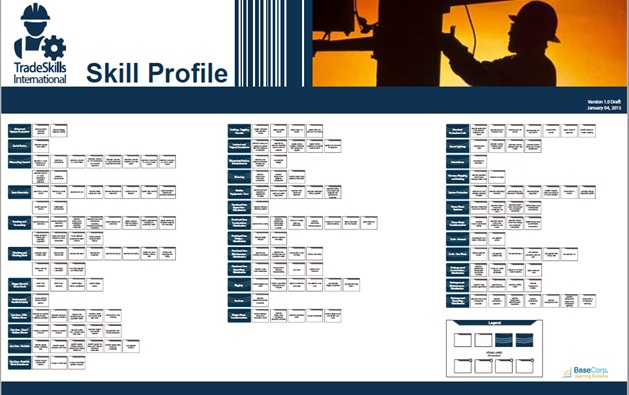Make Competency-Based Training Part of Your L&D Strategy
Sarah Flesher
A learner can indulge in self-study and view the procedure for changing an oil filter on a car's engine through animation or video. They can also read manuals and manufacturer's instructions on how the job is done. They can learn the expected torque to apply as they install the filter and what tests the filter must stand up to in order to demonstrate that it has been installed to specification.
But, he or she cannot understand what it feels like to tighten the filter firmly without doing so. They cannot practice changing an oil filter, nor demonstrate that they can successfully change an oil filter without getting their hands dirty. In other words, the learner must physically demonstrate competence in the skill. And the end result of the training will be a Yes or No answer to the question, "Can the learner install the oil filter to the expected standards and specifications?". Yes, and the learner is deemed competent in the skill. No, and the learner must revisit the learning materials and practice further until the skill is mastered.
That, in a nutshell, is competency-based training or CBT.
In this article, I'll discuss how you can make CBT a part of your learning and development strategy.
Building a competency-based training program
In a competency-based training program, standards are set and learners are provided with multiple types of support to ensure that those who are able to will meet the pre-set standards. But getting to that point takes some work.
A training needs analysis is useful for determining if training is required, and can demonstrate that CBT is what you need. Competency-based training providers use different processes in developing their programs, but most involve these 5 steps:
- Determine competencies/skills
- Specify job performance standards
- Identify and develop learning resources
- Validate learning resources
- Develop evaluation items
1. Determine competencies/skills
It all begins with skill profiling.
Skill profiling consists of documenting all the competencies required to work within the organization. This list of skills becomes the basis for the training curriculum and is typically developed in a one to two-day facilitated workshop. Ultimately, the workshop seeks to answer the question, "What do our people need to know and/or be able to do in order to successfully perform their jobs?"
All of the jobs are listed and then workshop participants, ideally from all levels within the company, list skills and discuss and debate as to whether the skills listed belong to the job or whether they are necessary at all.
Here's a simple example. The job is "Clean the teeth" with the required skills listed.

Over-simplified? Sure, but you get the picture. Each job and the skills required to do that job are documented. When you put it all together, the final result is a comprehensive snapshot of all of the skills the company requires in its workforce. Here's an example:

2. Specify job performance standards
Performance standards are enabling objectives based on the cognitive, attitudinal, and practical behaviours used to demonstrate competence. Standards specify the minimum acceptable level of expertise in the performance of a skill and how that performance will be measured. A performance standard should consist of:
- A rationale statement, which describes why the skill is important to the learner and to the job
- Conditions of performance, which describe the circumstances or conditions under which the skill is performed
- Performance objectives, which describe the steps taken to perform the skill or task
- Standards of performance, which specify the minimum acceptable level of expertise in the performance of a skill, and how that performance will be measured
3. Identify and develop learning resources
Now that you've identified the skills to be taught and written the standards that trainees will be expected to meet, it's time to figure out what you're going to use to train your learners. Remember, competency-based training has a knowledge-based component (self-study or classroom) and demonstration and practice components that must be completed before evaluation of competency. Learning resources for these components can include any or all of the following:
- Coaches (subject matter experts or mentors)
- Technical descriptions
- Standard operation procedures
- eLearning
- Institutional courses
- In-service delivery
- White papers
4. Validate learning resources
The learning resources that are developed need to be validated by subject matter experts to ensure accuracy and relevance. The resources must also reflect the current state of workplace systems, processes and procedures. These may change in the future, and the resources will have to be updated to reflect those developments as needed.
5. Develop evaluation items
Learner evaluation in a competency-based learning system is based on the performance standards and learning resources developed for each specific skill. The evaluations are objective because they rely on the predetermined standards rather than the subjective impressions of the evaluator.
Evaluating the knowledge component of competency-based training usually involves quizzes and tests that demonstrate the learner's understanding of the theory behind the skill. Practical skills are evaluated using evaluation checklists or procedures written for that purpose. Learners are given these at the beginning of their training and they are used by evaluators to document the learner's performance of the skill when the learner has decided that they are ready.
Incorporating competency-based training in your learning strategy
So, why should you make competency-based training a part of your L&D strategy? Competency-based training:
- Can be combined with other learning delivery methods: if your LMS can manage forums and discussion groups, you can create social learning areas for competency-based training. Letting learners share their experiences does not apply solely to eLearning. You can also recognize competency-based learning achievements by awarding Open Badges for competency completions. Competency-based learners can also make use of mobile learning, as they may need to check specifications or other details while practicing the practical part of their learning.
- Fits the 70:20:10 model of learning: this model argues that 70% of the things we learn are learned through doing (performing a skill). Competency-based training is all about learning through the physical practice of a skill.
- Can be assigned and tracked by individualized learning paths: if your LMS can assign and track learners by individual learning paths, it can do so for competency-based training programs. Progress and completions of the knowledge portion and the practical evaluation of CBT can all be mapped as learning paths, just like of the rest of your eLearning.
- Can be gamified: competency-based learning does not have to be dull. Just like other eLearning programs, CBT programs can be made more engaging by incorporating gamification features such as leaderboards, badges and progress bars.
Conclusion
While CBT has been around for decades, there is no reason that it cannot be incorporated into today's learning and development strategies. People still need to learn competencies and demonstrate them in their day-to-day workplace activities. For that reason, competency-based training is still a valid component of workplace training.
In this article, I've provided a basic model for building a competency-based training program. There are others available, but they all boil down to the same thing: teaching learners to perform skills to predetermined standards and then having them meet those standards to demonstrate competency in the skill.
I've also offered a few points on how CBT can be incorporated into a company's learning and development strategy. And, with the technology available, competency-based learning can be every bit as engaging, mobile and social as any other form of workplace learning. You just have to make it happen.
Free eBook
Optimizing Competency-Based Learning
Learn how competency-based learning could benefit your organization!
📘 Ready to Elevate Your Learning Strategy?
Explore our comprehensive library of eBooks and tools on learning resource development, competency-based learning, and LMS implementation. Transform your training programs with insights from industry experts and practical templates.
Sarah Flesher
Sarah is an Instructional Designer at BaseCorp Learning Systems and is currently completing a PhD in Educational Technology. Her research focuses on implementing competency-based learning systems in all types of organizations. When she doesn't have her nose in a book you can find her at the gym, on the ice, on the ski hill, drinking wine or in a coffee shop … with her nose in a book.

